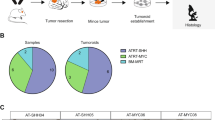Abstract
Atypical teratoid/rhabdoid tumors (ATRT) are rare, highly malignant, embryonal CNS tumors with a poor prognosis. Therapy relies on highly toxic chemotherapy and radiotherapy. To improve outcomes and decrease morbidity, more targeted therapy is required. Gene expression analysis revealed elevated expression of multiple kinases in ATRT tissues. Aurora Kinase A was one of the candidate kinases. The objective of this study was to evaluate the impact of Aurora Kinase A inhibition in ATRT cell lines. Our analysis revealed that inhibition of Aurora Kinase A induces cell death in ATRT cells and the small molecule inhibitor MLN 8237 sensitizes these cells to radiation. Furthermore, inhibition of Aurora Kinase A resulted in decreased activity of pro-proliferative signaling pathways. These data indicate that inhibition of Aurora Kinase A is a promising small molecule target for ATRT therapy.





Similar content being viewed by others
References
Bambakidis NC, Robinson S, Cohen M, Cohen AR (2002) Atypical teratoid/rhabdoid tumors of the central nervous system: clinical, radiographic and pathologic features. Pediatr Neurosurg 37:64–70
Hilden JM, Meerbaum S, Burger P, Finlay J, Janss A, Scheithauer BW, Walter AW, Rorke LB, Biegel JA (2004) Central nervous system atypical teratoid/rhabdoid tumor: results of therapy in children enrolled in a registry. J Clin Oncol 22:2877–2884
Reddy AT (2005) Atypical teratoid/rhabdoid tumors of the central nervous system. J Neurooncol 75:309–313
Gardner SL, Asgharzadeh S, Green A, Horn B, McCowage G, Finlay J (2008) Intensive induction chemotherapy followed by high dose chemotherapy with autologous hematopoietic progenitor cell rescue in young children newly diagnosed with central nervous system atypical teratoid rhabdoid tumors. Pediatr Blood Cancer 51:235–240
Chi SN, Zimmerman MA, Yao X, Cohen KJ, Burger P, Biegel JA, Rorke-Adams LB, Fisher MJ, Janss A, Mazewski C, Goldman S, Manley PE et al (2009) Intensive multimodality treatment for children with newly diagnosed CNS atypical teratoid rhabdoid tumor. J Clin Oncol 27:385–389
Biegel JA, Zhou JY, Rorke LB, Stenstrom C, Wainwright LM, Fogelgren B (1999) Germ-line and acquired mutations of INI1 in atypical teratoid and rhabdoid tumors. Cancer Res 59:74–79
Biegel JA, Tan L, Zhang F, Wainwright L, Russo P, Rorke LB (2002) Alterations of the hSNF5/INI1 gene in central nervous system atypical teratoid/rhabdoid tumors and renal and extrarenal rhabdoid tumors. Clin Cancer Res 8:3461–3467
Fujisawa H, Misaki K, Takabatake Y, Hasegawa M, Yamashita J (2005) Cyclin D1 is overexpressed in atypical teratoid/rhabdoid tumor with hSNF5/INI1 gene inactivation. J Neurooncol 73:117–124
Baselga J (2006) Targeting tyrosine kinases in cancer: the second wave. Science 312:1175–1178
Barton VN, Foreman NK, Donson AM, Birks DK, Handler MH, Vibhakar R (2010) Aurora kinase A as a rational target for therapy in glioblastoma. J Neurosurg Pediatr 6:98–105
El-Sheikh A, Fan R, Birks D, Donson A, Foreman NK, Vibhakar R (2010) Inhibition of aurora kinase A enhances chemosensitivity of medulloblastoma cell lines. Pediatr Blood Cancer 55:35–41
Giet R, Petretti C, Prigent C (2005) Aurora kinases, aneuploidy and cancer, a coincidence or a real link? Trends Cell Biol 15:241–250
Wang R, Wang JH, Chu XY, Geng HC, Chen LB (2009) Expression of STK15 mRNA in hepatocellular carcinoma and its prognostic significance. Clin Biochem 42:641–647
Baba Y, Nosho K, Shima K, Irahara N, Kure S, Toyoda S, Kirkner GJ, Goel A, Fuchs CS, Ogino S (2009) Aurora-A expression is independently associated with chromosomal instability in colorectal cancer. Neoplasia 11:418–425
Ogawa E, Takenaka K, Katakura H, Adachi M, Otake Y, Toda Y, Kotani H, Manabe T, Wada H, Tanaka F (2008) Perimembrane aurora-A expression is a significant prognostic factor in correlation with proliferative activity in non-small-cell lung cancer (NSCLC). Ann Surg Oncol 15:547–554
Milam MR, Gu J, Yang H, Celestino J, Wu W, Horwitz IB, Lacour RA, Westin SN, Gershenson DM, Wu X, Lu KH (2007) STK15 F31I polymorphism is associated with increased uterine cancer risk: a pilot study. Gynecol Oncol 107:71–74
Yang SB, Zhou XB, Zhu HX, Quan LP, Bai JF, He J, Gao YN, Cheng SJ, Xu NZ (2007) Amplification and overexpression of aurora-A in esophageal squamous cell carcinoma. Oncol Rep 17:1083–1088
Kitzen JJ, de Jonge MJ, Verweij J (2009) Aurora kinase inhibitors. Crit Rev Oncol Hematol 73:99–110
Lee S, Cimica V, Ramachandra N, Zagzag D, Kalpana GV (2011) Aurora A is a repressed effector target of the chromatin remodeling protein INI1/hSNF5 required for rhabdoid tumor cell survival. Cancer Res 71:3225–3235
Barton VN, Donson AM, Kleinschmidt-DeMasters BK, Birks DK, Handler MH, Foreman NK (2010) Unique molecular characteristics of pediatric myxopapillary ependymoma. Brain Pathol 20:560–570
Birks DK, Kleinschmidt-Demasters BK, Donson AM, Barton VN, McNatt SA, Foreman NK, Handler MH (2010) Claudin 6 is a positive marker for atypical teratoid/rhabdoid tumors. Brain Pathol 20:140–150
Liu X, Erikson RL (2002) Activation of Cdc2/cyclin B and inhibition of centrosome amplification in cells depleted of Plk1 by siRNA. Proc Natl Acad Sci USA 99:8672–8676
Squire SE, Chan MD, Marcus KJ (2007) Atypical teratoid/rhabdoid tumor: the controversy behind radiation therapy. J Neurooncol 81:97–111
Taylor S, Peters JM (2008) Polo and aurora kinases: lessons derived from chemical biology. Curr Opin Cell Biol 20:77–84
Maris JM, Morton CL, Gorlick R, Kolb EA, Lock R, Carol H, Keir ST, Reynolds CP, Kang MH, Wu J, Smith MA, Houghton PJ (2010) Initial testing of the aurora kinase A inhibitor MLN8237 by the pediatric preclinical testing program (PPTP). Pediatr Blood Cancer 55:26–34
Acknowledgments
The authors thank the Department of Pediatrics and The Children’s Hospital Denver for their support and Morgan Adams Foundation (to NF and RV); National Institutes of Health (KO8 NS59790 to RV) for funding.
Author information
Authors and Affiliations
Corresponding author
Electronic supplementary material
Below is the link to the electronic supplementary material.
Rights and permissions
About this article
Cite this article
Venkataraman, S., Alimova, I., Tello, T. et al. Targeting Aurora Kinase A enhances radiation sensitivity of atypical teratoid rhabdoid tumor cells. J Neurooncol 107, 517–526 (2012). https://doi.org/10.1007/s11060-011-0795-y
Received:
Accepted:
Published:
Issue Date:
DOI: https://doi.org/10.1007/s11060-011-0795-y




